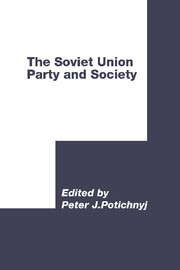Book contents
- Frontmatter
- Contents
- List of figures
- List of tables
- List of contributors
- Foreword by R. C. Elwood
- Preface by P. J. Potichnyj
- Part 1 Party apparat
- Part 2 Socialization and political discourse
- 4 Political socialization in the USSR: April 1979 and after
- 5 Political language and political change in the USSR: notes on the Gorbachev leadership
- 6 Soviet political discourse, narrative program and the Skaz theory
- 7 The nationality policy of the CPSU and its reflection in Soviet socio-political terminology
- 8 The evolution of the local soviets
- Part 3 Social policy
- Index
- Publications from the Third World Congress for Soviet and East European Studies
8 - The evolution of the local soviets
from Part 2 - Socialization and political discourse
Published online by Cambridge University Press: 04 August 2010
- Frontmatter
- Contents
- List of figures
- List of tables
- List of contributors
- Foreword by R. C. Elwood
- Preface by P. J. Potichnyj
- Part 1 Party apparat
- Part 2 Socialization and political discourse
- 4 Political socialization in the USSR: April 1979 and after
- 5 Political language and political change in the USSR: notes on the Gorbachev leadership
- 6 Soviet political discourse, narrative program and the Skaz theory
- 7 The nationality policy of the CPSU and its reflection in Soviet socio-political terminology
- 8 The evolution of the local soviets
- Part 3 Social policy
- Index
- Publications from the Third World Congress for Soviet and East European Studies
Summary
The word “soviet” in Russian means advice, or counsel. Only in the twentieth century has it taken on the second meaning of a council referring to institutions of government comprised of elected representatives. The absence of such usage prior to 1905 indicates that these institutions lack roots in the political traditions of either the village or the autocracy but are sui generis in Russian history. In what follows, the evolution of local government in the Soviet period will be reviewed to determine whether a sufficient theoretical and legal basis has emerged to allow for the expansion of political participation at this level in the contemporary period.
In fact, the use of the word “soviet,” in its second meaning of a council, referred not to institutions of government but to committees of factory workers, chosen by their peers to negotiate with their employers and with the state during the strikes which emerged around the end of the nineteenth century during Russia's period of nascent industrialization. Such committees would arise on an ad hoc basis, often at the request of management, perform their function of communicating workers' grievances, and then be disbanded, not infrequently with the dismissal from work of those workers who took part.
The emergence of the idea of the soviet as a quasi-permanent body with a political character occurred at the time of the Revolution of 1905. The first of these is generally considered to have appeared in May 1905, in the textile center of Ivanovo–Voznesensk in Vladimir province, about 200 miles northeast of Moscow.
- Type
- Chapter
- Information
- The Soviet Union: Party and Society , pp. 142 - 158Publisher: Cambridge University PressPrint publication year: 1988



